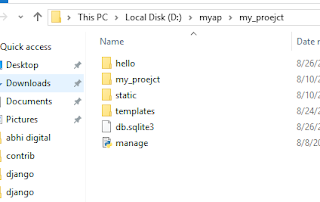Open command prompt in windows
then in command prompt type d:
and press enter .
and use following commands
To create folder myap -execute the following command:
D:\> mkdir myap
To go myap folder path -execute the following command:
D:\>cd myap
To create a virtual environment for your project, open a new command prompt, navigate to the myap folder where you want to create your project and then execute the following command:-
D:\myap>python -m venv env
In the command prompt, ensure your virtual environment is active, and execute the following command:
D:\myap>env\Scripts\activate
execute the following command to install django.
D:myap>pip install django
run the following command - This will create a myproject directory in your current directory
D:\myap>django-admin startproject myproject
then go to myproject folder path type following command :-
D:\myap>cd myproejct
To create your app, make sure you’re in the your project directory & type this command:
D:\myap\myproejct>python manage.py startapp hello
That’ll create a directory hello app folder inside my_project folder:
after it open your myap folder inside it you will see my_project folder
Views :-
Django views are Python functions that takes http requests and returns http response, like HTML documents.
A web page that uses Django is full of views with different tasks and missions.
Views are usually put in a file called views.py located on your app's folder.
There is a views.py in your members folder that looks like this:
hello/views.py:
from django.shortcuts import render
# Create your views here.Find it and open it, and replace the content with this:
hello/views.py:
from django.shortcuts import render
from django.http import HttpResponse
def index(request):
return HttpResponse("Hello world!")This is a simple example on how to send a response back to the browser.
But how can we execute the view? Well, we must call the view via a URL.
URLs
Create a file named urls.py in the same folder as the views.py file, and type this code in it:
hello/urls.py:
from django.urls import path
from . import views
urlpatterns = [
path('', views.index, name='index'),
]
The urls.py file you just created is specific for the hello application. We have to do some routing in the root directory myproject as well. This may seem complicated, but for now, just follow the instructions below.
There is a file called urls.py on the myproject folder, open that file and add the include module in the import statement, and also add a path() function in the urlpatterns[] list, with arguments that will route users that comes in via 127.0.0.1:8000/hello/.
Then your file will look like this:
myproject/urls.py:
from django.contrib import admin
from django.urls import include, path
urlpatterns = [
path('hello/', include('hello.urls')),
path('admin/', admin.site.urls),
]If the server is not running, navigate to the /myproject folder and execute this command in the command prompt:
py manage.py runserverIn the browser window, type 127.0.0.1:8000/hello/ in the address bar.
Sign up here with your email


ConversionConversion EmoticonEmoticon